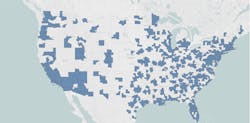Local Markets in Texas & Florida See Double-Digit Surges in Population from 2020 to 2024
One of the easiest way to forecast the economic prospects of local market areas is to track their annual popular growth data released each year by the U.S. Census Bureau. Big swings in population — either positively or negatively — can affect the housing market, specifically building permits; the amount of money spent on residential home improvements; retail sales, light commercial construction; and even the number of representatives a geographic area has in Congress.
In addition to the impact of population increases on a local market's overall economy, they also may impact distributors’ decisions about where to set up a new location, manufacturers’ sales goals or rep representation in a local level.
The tables below highlight the Metropolitan Statistical Areas (MSAs), counties and micropolitan areas with the largest increases in new residents from 2020 to 2024, the most recent data available. You can download the data for all local markets as well as states by clicking on the file below
While the U.S. population as a whole increased +2.6% over the past four years, the population in many of the fastest-growing markets grew at double-digit rates.
MSAs
The MSAs with the largest percent increases from 2020 to 2024 included Lakeland-Winter Haven, FL, MSA (+16.9%); Cape Coral-Fort Myers, FL, MSA (+12.5%); Austin-Round Rock-San Marco, TX, MSA (+10.9%); and Raleigh-Cary, NC, MSA (+10.2%).
COUNTIES
Standing out as some of the fastest-growing counties over the past four years were Collin (+16.6%) and Denton Counties (+14.3%) in the Dallas metro; Fort Bend (+15.6%) and Montgomery (+19.9%) Counties in the Houston metro; Polk County (+16.8%) in the Lakeland, FL, metro; and the Austin metro’s Williamson County (+18.2%).
Small But Mighty in Their Own Way
You may also want to check out the U.S. Census data for smaller markets called Micropolitan areas.
These geographic market areas have what the government defines as an “urban cluster" with a population between 10,000 and 50,000, as well as some adjacent towns. They are particularly important for electrical distributors to watch in case they are looking for fast-growing markets outside of an urban core where they can set up a new branch.
These market areas are typically in more rural areas, but some of them still saw double-digit growth from 2020 to 2024. Some fast-growing micropolitan areas to watch include Seaford, DE (+13.6%); Jefferson, GA (+22.3%); Clewiston, FL (+14.4%); Brigham City, UT/ID (+10.5%); and Sandpoint ID (+13.8%).
Downloadable Population Data: State, Metro, County and Micropolitan Area
About the Author
Jim Lucy
Editor-in-Chief
Over the past 40-plus years, hundreds of Jim’s articles have been published in Electrical Wholesaling and Electrical Marketing newsletter on topics such as the impact of new competitors on the electrical market’s channels of distribution, energy-efficient lighting and renewables, and local market economics. In addition to his published work, Jim regularly gives presentations on these topics to C-suite executives, industry groups and investment analysts.
He launched a new subscription-based data product for Electrical Marketing that offers electrical sales potential estimates and related market data for more than 300 metropolitan areas, and in 1999 he published his first book, “The Electrical Marketer’s Survival Guide” for electrical industry executives looking for an overview of key market trends.
While managing Electrical Wholesaling’s editorial operations, Jim and the publication’s staff won several Jesse H. Neal awards for editorial excellence, the highest honor in the business press, and numerous national and regional awards from the American Society of Business Press Editors. He has a master’s degree in Communications and a bachelor’s degree in Journalism from Glassboro State College, Glassboro, N.J. (now Rowan University).
